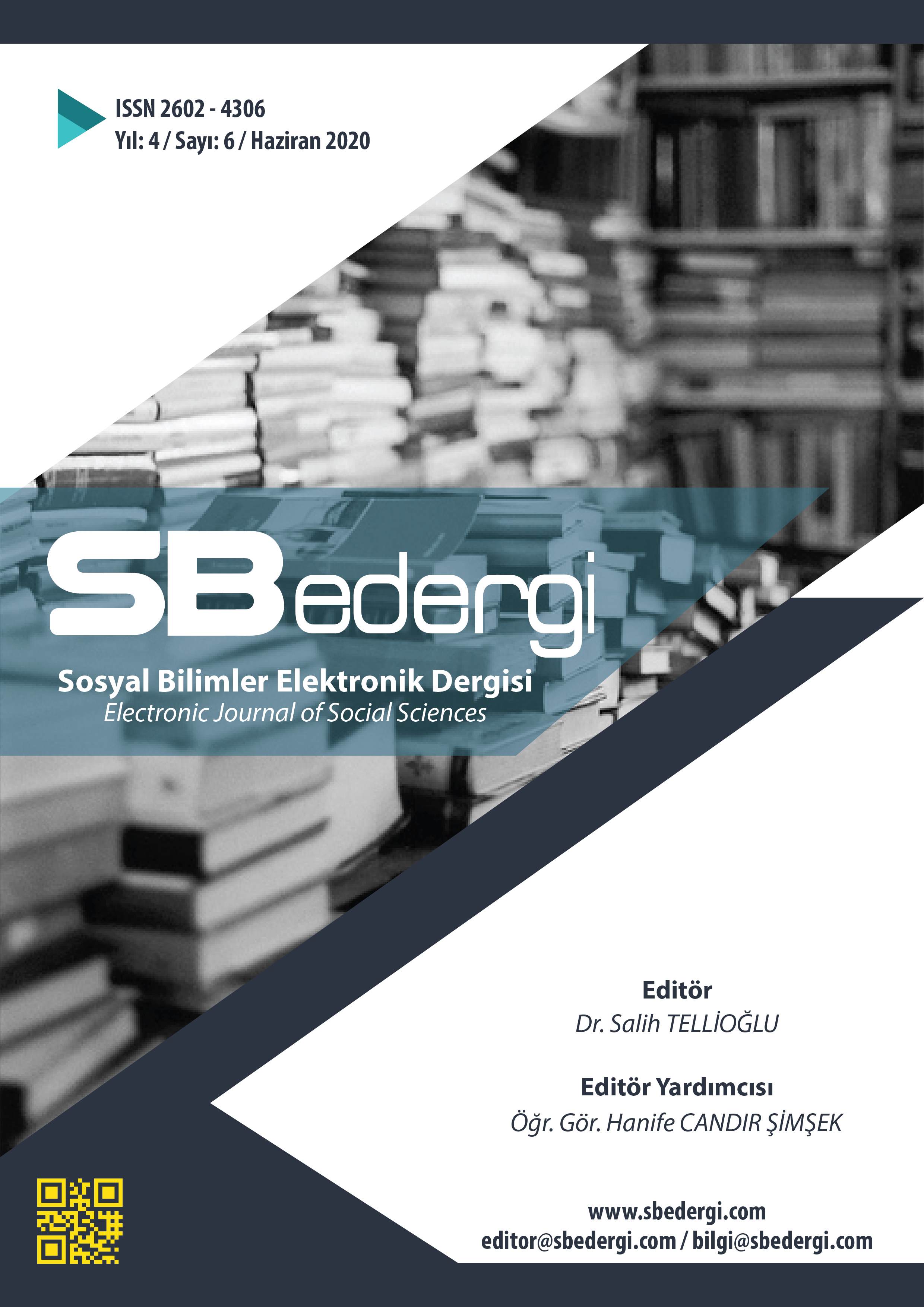Author :
Abstract
İnsanların tüketim alışkanlıkları nedeniyle yenilenemeyen kaynakların hızla tüketildiği bir dönemdeyiz. Bu tüketim alışkanlığı çevre sorunlarına sebep olarak insan ve toplum sağlığına zarar vermeye başlamıştır. Kaynakların korunması bağlamında atıkların geri kazanımı oldukça önem kazanmaktadır. Tüketim sonrası ortaya çıkan atıkların geri kazanımı birkaç yöntemle sağlanmaktadır. Yöntemlerden çoğunda endüstriyel işlem uygulanarak az da olsa enerji harcanırken, ‘ileri dönüşüm’ için enerji tüketimi söz konusu değildir. Fakat endüstriyel işlem gerektirmese bile atıkların bir yerden başka bir yere taşınması veya depolanması bile kaynakların kullanımı ile mümkündür. Bu nedenle atıkların yerinde değerlendirilmesi oldukça önemlidir. Yerinde değerlendirme ise ancak ‘ileri dönüşüm’ yöntemi ile mümkün olmaktadır. Yeni bir kavram olması nedeniyle ‘ileri dönüşüm’, günümüzde çok az kişi tarafından bilindiği için yeterince kullanılmamaktadır. Bu çalışmada ‘ileri dönüşüm’ yöntemi ile ürün tasarımına örnek verilerek, ileri dönüşüm bilincinin oluşturulmasına katkı sağlamak amaçlanmaktadır.
Keywords
Abstract
We are in a period where resources that cannot be renewed due to people's consumption habits are consumed rapidly. This consumption habit has started to harm human and community health by causing environmental problems. In the context of resource conservation, the recovery of waste is very important. Recycling of wastes that arise after consumption is provided by several methods. While most of the methods use a little amount of energy by applying industrial processes, there is no energy consumption for ‘upcycling’. However, even if it does not require industrial treatment, it is possible to transport or store wastes from one place to another with the use of resources. For this reason, it is very important to evaluate waste on site. On-site evaluation is only possible with the ‘upcycling’ method. Since it is a new concept,’ upcycling’ is not used enough because it is known to very few people today. In this study, it is aimed to contribute to the creation of ‘upcycling’ awareness by giving an example of product design with the ‘upcycling’ method.
Keywords
- Akdoğan, A. Ve Güleç, S. (2007). Sürdürülebilir Katı Atık Yönetimi ve Belediyelerde Yöneticilerin Katı Atık Yönetimiyle İlgili Tutum ve Düşüncelerinin Analizine Yönelik Bir Araştırma, Hacettepe Üniversitesi İktisadi ve İdari Bilimler Fakültesi Dergisi, 1(25), 39-69. http://static.dergipark.org.tr/articledownload/2651/89e7/91d6/592be9dcf2acd.pdf?
- Ambalaj Atıklarının Kontrolü Yönetmeliği, 2017. Erişim adresi: https://www.resmigazete.gov.tr/eskiler/2017/12/20171227-12.htm. Erişim tarihi: 08.04.2020.
- Ambalaj Sanayicileri Derneği. Erişim adresi: http://www.ambalaj.org.tr/tr/default.html. Erişim tarihi:14.10.2019
- Bek, Y. (2019). Türkiye’de Geri Dönüşüm Uygulamaları (3R). Yüksek Lisans Tezi, Ondokuz Mayıs Üniversitesi Fen Bilimleri Enstitüsü, Samsun.
- Bilgi Üniversitesi Moda ve Tasarım Bölümü Öğrencileri İleri Dönüşüm Sergisi. Erişim adresi: https://www.bilgi.edu.tr/tr/etkinlik/9591/moda-tasarim-studyosu-1-ogrenci-islerisergisi-ileri-donusum-upcycling/. Erişim tarihi: 30.01.2020.
- Bridgens, B., Powell, M., Farmer, G., Walsh, Ch., Reed, E., Royapoor, M., Gosling, P., Hall, J. Ve Heidrich O. (2018). Creative Upcycling: Reconnecting People, Materials and Place Through Making. Journal Of Cleaner Production, 189, 145-154. https://www.researchgate.net/publication/324177756_Creative_upcycling_Reconnecti ng_people_materials_and_place_through_making
- Çevre ve Şehircilik Bakanlığı. Atıklar. Erişim adresi: https://webdosya.csb.gov.tr/db/destek/icerikler/10_at-kler_brosur20191128080759.pdf. Erişim tarihi : 01.04.2020.
- Çoruh, Doç.Dr. E., Avcıoğlu Kalebek, Doç.Dr. N., Özdemir, Dr.Öğr.Üye. G. ve Öztürk Öğr.Gör. T. (2018). Geri Dönüşüm Kapsamında İkinci El Giysilerin Tekrar Kullanıma Dönüştürülmesi ve Sürdürülebilirlik. SSS Journal – Social Sciences Studies Journal, 4(21), 3208-3213. http://sssjournal.com/Makaleler/2011261543_14_421.ID738.%20%c3%87oruh%20vd_3208-3213.pdf.
- Dal, İ. Ve Cengiz Gökçe, G. (2019). Sürdürülebilirlik Yolunda İleri Dönüşüm: Bir Atölye Çalışması. İnönü Üniversitesi Journal Of Art And Design, 9(20), 30-38. http://static.dergipark.org.tr/article-download/2c8d/123d/58f0/5e0f666786061.pdf?
- Atık Yönetimi Mevzuatı, 2015 Erişim adresi: https://www.mevzuat.gov.tr/mevzuat?MevzuatNo=20644&MevzuatTur=7&MevzuatT ertip=5 Erişim tarihi: 01.04.2020.
- Gündüzalp, A.A. ve Güven, S. (2016). Atık, Çeşitleri, Atık Yönetimi, Geri Dönüşüm ve Tüketici: Çankaya Belediyesi ve Semt Tüketicileri Örneği. Hacettepe Üniversitesi – Sosyolojik Araştırmalar E-Dergisi. http://www.sdergi.hacettepe.edu.tr/makaleler/AtikCesitleri-Yonetimi-GeriDonusumVeTuketici.pdf
- Güner, Y. (2019). İleri Dönüşüm (Upcycle) Yöntemiyle Kadınlara Giysilerden Yeni Ürün Geliştirme Becerilerinin Kazandırılması (Ankara-Keçmek Örneği). Yüksek Lisans Tezi, Gazi Üniversitesi Güzel Sanatlar Enstitüsü, Ankara.
- Hasanoğlu, P. (2012). Düzce Evsel ve Endüstriyel Atıklardan Geri Kazanılabilir Maddelerin Potansiyelinin Araştırılması. Yüksek Lisans Tezi, Süleyman Demirel Üniversitesi Fen Bilimleri Enstitüsü, Isparta.
- İtü ve Lee Cooper İleri Dönüşüm Koleksiyonu. Erişim adresi: https://haberler.itu.edu.tr/haberdetay/2020/02/11/i-tu-ve-lee-cooper-turkiye-den-i-leridonusum-koleksiyonu. Erişim tarihi: 20.02.2020.
- Sıfır Atık Yönetmeliği, 2019, Erişim adresi: https://www.resmigazete.gov.tr/eskiler/2019/07/20190712-9.htm Erişim tarihi: 03.02.2020
- Su Kirliliği Kontrolü Yönetmeliği, 2014. Erişim adresi: https://www.mevzuat.gov.tr/mevzuat?MevzuatNo=7221&MevzuatTur=7&MevzuatTe rtip=5. Erişim tarihi: 12.04.2020.
- URL-1, (2020). Atık Sahası. Erişim adresi: http://atiksahasi.com/ Erişim tarihi: 03.04.2020
- URL-2, (2020). PAGEV’in (Türk Plastik Sanayicileri Araştırma Geliştirme ve Eğitim Vakfı) Geri Dönüşüm İktisadi İşletmesi. Erişim adresi: http://www.pagcev.org/. Erişim tarihi: 12.12.2019.
- URL-3, (2020). Sıfır Atık. Erişim adresi: https://sifiratik.co/ Erişim tarihi: 10.04.2020.
- Yıldırım, L. (2017). Geri Dönüşüm/İleri Dönüşüm/Tekrar Kullanım Kapsamında İkinci El Giysiler ve Sürdürülebilirlik. SDÜ ART-E – Süleyman Demirel Üniversitesi Güzel Sanatlar Fakültesi Sanat Dergisi, 10(20), 484-503. http://static.dergipark.org.tr/articledownload/eeb6/c4d3/42a6/5a4681f2e7407.pdf?





